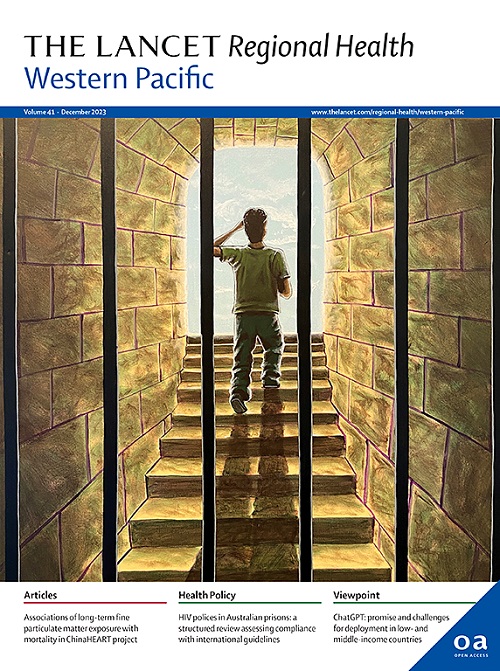揭示提高中国农村高血压和糖尿病护理的途径:使用护理级联模型的混合方法研究
IF 7.6
1区 医学
Q1 HEALTH CARE SCIENCES & SERVICES
引用次数: 0
摘要
背景:在高血压和糖尿病的筛查、诊断、治疗和控制方面仍存在重大差距。本研究旨在评估中国农村这些疾病的护理级联,确定每个阶段的障碍和促进因素,为改善护理提供策略提供信息。方法采用顺序探索性混合方法,于2023年7月至2024年6月在中国三个农村县(临朐、巩义、武冈)进行研究。定性阶段包括对政策制定者、医疗保健提供者和患者的深入访谈,以确定每个护理级联阶段的背景障碍和促进因素。从定性阶段获得的见解为随后的定量调查工具的设计提供了信息。该调查对农村居民进行了分层,非随机抽样,以定量评估定性阶段确定的因素。研究结果对82名参与者进行了定性访谈,其中包括10名政策制定者、36名医疗保健提供者和36名高血压和/或糖尿病患者。共有7488名35-74岁的农村居民完成了定量调查。其中,2668人(35.6%)单独患有高血压,516人(6.9%)单独患有糖尿病,977人(13.0%)同时患有两种疾病。所有疾病的护理级联显示出明显的差距,疾病不受控制的比例很高:高血压为87.6%,糖尿病为72.3%,两种疾病均为96.6%。综合定性和定量分析突出了患者层面的主要障碍,包括对疾病严重程度的误解、对护理需求的认知不足、对诊断和终身用药的恐惧。初级保健的资源限制加剧了提供者和系统层面的挑战,如有限的诊断能力和不一致的随访。促进因素包括牢固的医患关系、有针对性的健康教育举措、数字工具的使用和慢性病报销政策。通过定性和定量相结合的方法,本研究确定了高血压、糖尿病以及合并高血压和糖尿病患者的不同护理级联。该研究强调需要采取综合的、针对具体情况的战略,包括加强健康教育、加强初级保健系统和采用电子卫生系统,以提高中国农村医疗服务的连续性。本研究由中国医学科学院资助:中央研究院基金(批准号:2022-ZHCH330-01和2021-RC330-004);WH10022022010)。本文章由计算机程序翻译,如有差异,请以英文原文为准。
Unveiling pathways to enhance hypertension and diabetes care in rural China: a mixed methods study using the care cascade model
Background
Significant gaps remain in the screening, diagnosis, treatment, and control of hypertension and diabetes. This study aimed to assess the care cascade for these conditions in rural China, identifying barriers and facilitators at each stage to inform strategies for improving care delivery.
Methods
A sequential exploratory mixed methods study was conducted from July 2023 to June 2024 across three rural counties in China (Linqu, Gongyi, Wugang). The qualitative phase included in-depth interviews with policymakers, healthcare providers, and patients to identify contextual barriers and facilitators across each care cascade stage. Insights from the qualitative phase informed the design of a subsequent quantitative survey tool. The survey was administered to a stratified, non-random sample of rural residents to quantitatively assess factors identified in the qualitative phase.
Findings
Qualitative interviews were conducted with 82 participants, including 10 policymakers, 36 healthcare providers, and 36 patients with hypertension and/or diabetes. There were 7488 rural residents aged 35–74 years who completed the quantitative survey. Of these, 2668 (35.6%) had hypertension alone, 516 (6.9%) had diabetes alone, and 977 (13.0%) had both conditions. The care cascade for all conditions revealed significant gaps, with high rates of uncontrolled disease: 87.6% for hypertension, 72.3% for diabetes, and 96.6% for those with both conditions. Integrated qualitative and quantitative analyses highlighted key barriers at the patient level, including misconceptions about disease severity, low perceived need for care, and fear of diagnosis and lifelong medication use. Provider and system-level challenges, such as limited diagnostic capacity and inconsistent follow-up, were exacerbated by resource constraints in primary care. Facilitators included strong patient–provider relationships, targeted health education initiatives, the use of digital tools, and chronic disease reimbursement policies.
Interpretation
By combining qualitative and quantitative methods, the study identifies distinct care cascades for hypertension, diabetes, and comorbid hypertension and diabetes patients. The study highlights the need for integrated, context-specific strategies, including enhanced health education, stronger primary care systems, and the adoption of electronic health systems to improve the continuity of care in rural China.
Funding
This study was supported by the Chinese Academy of Medical Sciences through the following grants: Central Research Institute Fund (Grant Nos. 2022-ZHCH330-01 and 2021-RC330-004) and the Disciplines Construction Project: Population Medicine (Grant No. WH10022022010).
求助全文
通过发布文献求助,成功后即可免费获取论文全文。
去求助
来源期刊

The Lancet Regional Health: Western Pacific
Medicine-Pediatrics, Perinatology and Child Health
CiteScore
8.80
自引率
2.80%
发文量
305
审稿时长
11 weeks
期刊介绍:
The Lancet Regional Health – Western Pacific, a gold open access journal, is an integral part of The Lancet's global initiative advocating for healthcare quality and access worldwide. It aims to advance clinical practice and health policy in the Western Pacific region, contributing to enhanced health outcomes. The journal publishes high-quality original research shedding light on clinical practice and health policy in the region. It also includes reviews, commentaries, and opinion pieces covering diverse regional health topics, such as infectious diseases, non-communicable diseases, child and adolescent health, maternal and reproductive health, aging health, mental health, the health workforce and systems, and health policy.
 求助内容:
求助内容: 应助结果提醒方式:
应助结果提醒方式:


